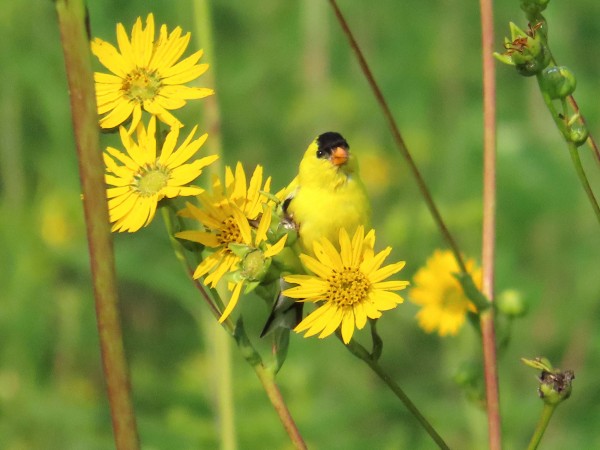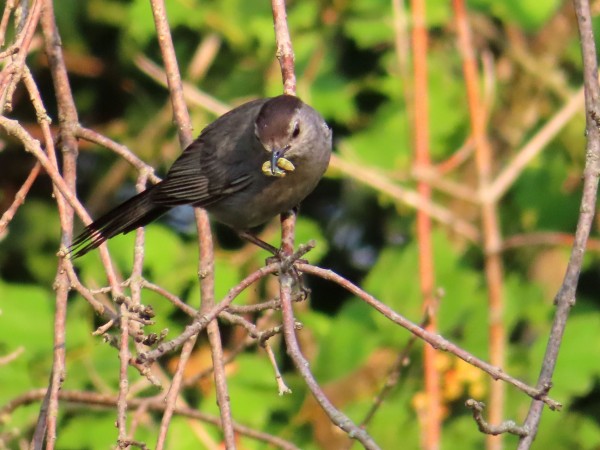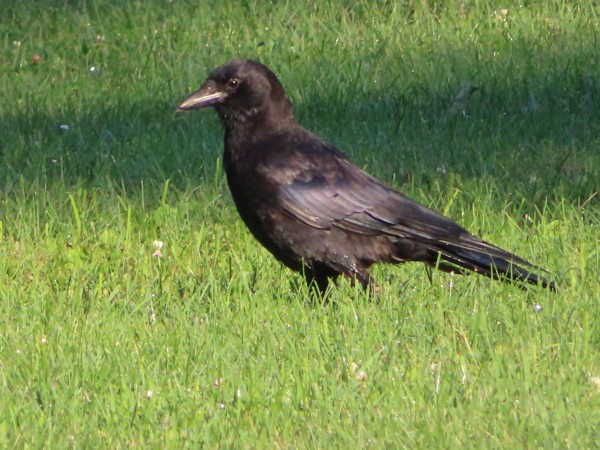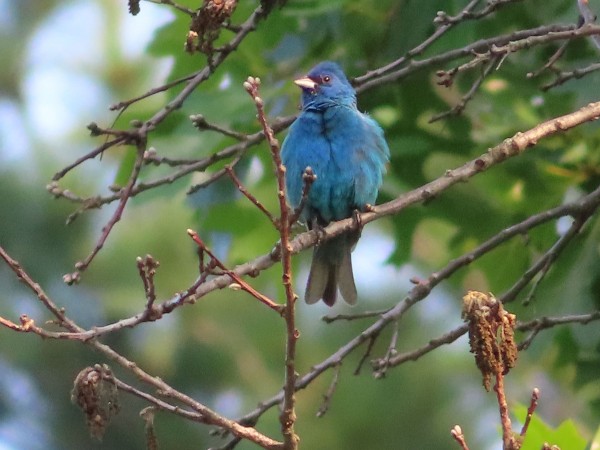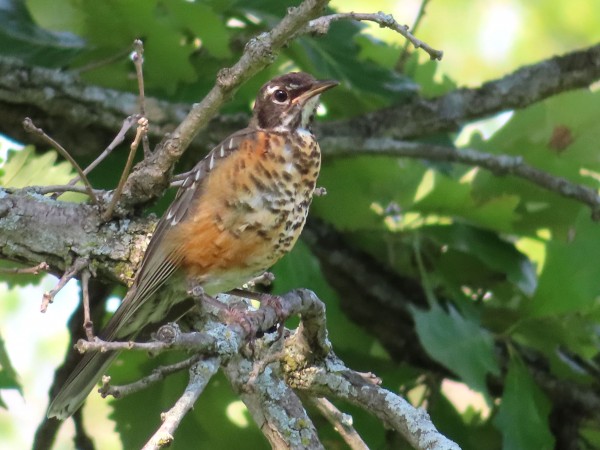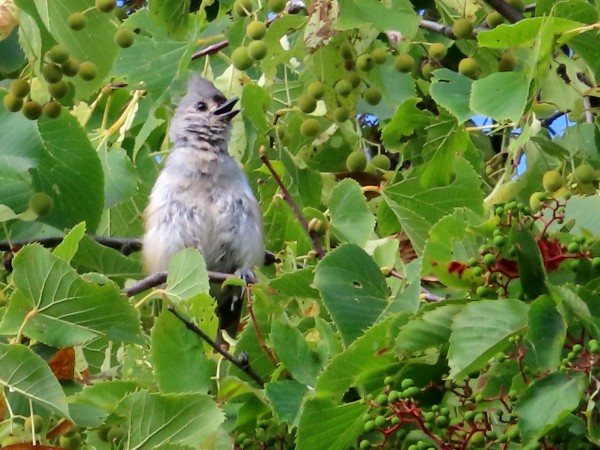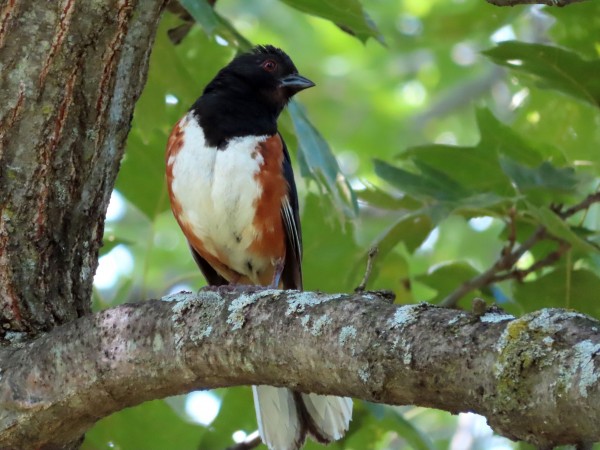Chuck's Birding Report #72
27 July - 02 August 2021
Dear fellow flock of birders,
The wild flowers in the Arb continue to grow and change. I would say the main color of the flowers right now is yellow and the tall plants are dominant with yellow flowers. One that has really grown tall this past week is the Prairie Dock. Look for this 9-10 foot tall plant with terminal yellow flowers just north of Curtis Pond over by West Curtis Prairie. Not only are the plants tall but the basal leave are very large too. One additional yellow flower beginning to bloom is the Goldenrod. There are several different kinds that will bloom now and for the next month or two. I'm adding another yellow bird on yellow flower this week. They really look good together. Included is a photo of an American Goldfinch on yellow flowers. (I forgot to pay attention to the species.)
What have the birds been doing this past week?
I always hope that I can find something special on my Monday morning bird walk so I can write about it in my report. I got lucky this morning. Just as I was stepping out my car at 6:30am in the Visitor Center parking lot of the Arb over flew our special family of Sandhill Cranes composed of two adults and two colts. We have been watching these cranes since May 9th when I first saw the small colts with their parents on Curtis Prairie. They have really grown these past almost three months. I saw the colts practice flying a bit on Longenecker but only a couple feet off the ground and flying only 20 to 30 feet. This is the first time I've seen them fly 40 to 50 feet in the air above me and disappear a half mile away. I was so awestruck that I forgot to photograph the event. I hope all of you can see them flying around the Arb.
Another bird that often greats me in the parking lot or very nearby is the Gray Catbird. It seems like they are meowing more recently. They have reproduced well in the Arb. I'm seeing 10-20 every time I walk in the Arb. Yesterday I saw one carrying a worm or caterpillar so I had to take a photo. The photo is included.
Speaking of the parking lot, one of the first things I do when starting my walk is to look over Curtis Prairie just to the south of the lot. I like to count all the Red-winged Blackbirds perched on the small trees and bushes on the prairie. I looked today and did not find one and for the whole morning I only saw two. Most of the Red-winged Blackbirds leave the prairie when finished raising their young. They don't migrate yet but gather in large flocks and feed in farm fields and the like. You might start seeing these large flocks when driving out in the countryside.
Yesterday I saw a couple American Crows chasing a raptor. I didn't know what it was at first but after looking at it with my binoculars it turned out to be a Cooper's Hawk. I always have the feeling they are really serious about the chase. They seem to take turns chasing one another as if they are playing tag. I couldn't capture the chase so I'm just including photos of each species.
Over the past couple weeks I've really seen a lot of the Indigo Bunting. I've seen at least 6 males and a couple females. I've also seen one male feed a fledgling and one female feed a fledgling. I've never seen that before. I've also seen a female on Curtis Prairie and another on the Grady Tract each feed a cowbird fledgling. All of the above were new events for me. I don't have photos of the feedings but I am including a photo of the male Indigo Bunting.
I've also seen lots of young birds this past week especially more young American Robins with distinct spotted breasts. That proves they are part of the thrush family. Photo included.
This morning while walking on Arboretum Drive near Gallistel Woods I heard the Peter, Peter, Peter song of the Tufted Titmouse. I looked up and there is was in the tree singing away. A photo is included.
Also this morning I birded the Grady Tract. The special bird I always find there is the Eastern Towhee. It was singing its "Drink you tea" song. I was able to see both a male and a female. They are really colorful birds. A photo of the male is included.
Some birds are beginning to migrate south already. Certainly shorebirds are early migrators. The Arboretum does not have much habitat for shorebirds so we don't see them in the Arb very often. One passerine the begins migrating early is the Baltimore Oriole. I haven't seen many in the Arb recently but I was at another Dane County site where there are usually many Baltimore Orioles and I only saw one but it was beautiful so I wanted to share a photo of it with you. It was pretty well hidden but I got a photo of most of it. The oriole was molting from its immature plumage to a mature plumage so it is part yellow and part orange in addition to a black head. I hope you like it.
That's my bird report for this week.
Good health to all of you and good birding too,
Chuck

